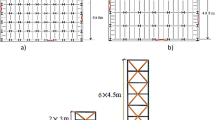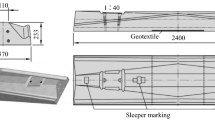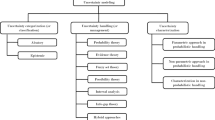Abstract
Shakedown analysis is an attractive method for determining the capacity of geostructures to sustain repeated loads involving a large number of cycles, e.g. rolling and sliding train wheel loads. Its main advantage is that it comes at a significantly reduced computational cost, compared to standard time-domain analyses. An essential component of shakedown analysis is the derivation of closed-form solutions to compute stresses due to the external repeated loads, a task that is not always feasible for complex problems as the ballasted rail track discussed herein. To tackle this, we present in this paper the use of finite element tools to obtain a quasi-lower-bound shakedown load numerically. The proposed method is based on the computation of the three-dimensional elastic stress field numerically, and the estimation of the shakedown load iteratively via an optimisation subroutine implemented in ABAQUS. Following a short presentation of this concept, we compare the elastic stress fields from models featuring varying degree of complexity, with the aim of identifying an optimal discretisation of the problem. This approach can be used for optimising the design of ballasted track structure, and this concept is briefly presented via a parametric study.







Similar content being viewed by others
References
American Railway Engineering and Maintenance-of-Way Association (2012) AREMA manual for railway engineering, vol 1. American Railway Engineering and Maintenance-of-Way Association, Landover
Bocciarelli M, Cocchetti G, Maie G (2004) Shakedown analysis of train wheels by Fourier series and nonlinear programming. Eng Struct 26:455–470
Boulbibane M, Weichert D (1997) Application of shakedown theory to soils with non-associated flow rules. Mech Res Commun 24(5):516–519
Brown SF, Yu HS, Juspi S, Wang J (2012) Validation experiments for lower-bound shakedown theory applied to layered pavement systems. Géotechnique 62(10):923–932
Chazallon C, Allou F, Hornych P, Mouhoubi S (2009) Finite elements modelling of the long-term behaviour of a full-scale flexible pavement with the shakedown theory. Int J Numer Anal Meth Geomech 33(1):45–70
China Railway Ministry (2010) Code for design of high-speed railway (for trial implementation). China Railway Publishing House, Beijing
Eason G (1965) The stresses produced in a semi-infinite solid by a moving surface force. Int J Eng Sci 2(6):581–609
Galvin P, Romero A, Dominguez J (2010) Fully three-dimensional analysis of high-speed train–track–soil-structure dynamic interaction. J Sound Vib 329:5147–5163
Ghadimi B, Nikraz H, Rosano M (2016) Dynamic simulation of a flexible pavement layers considering shakedown effects and soil-asphalt interaction. Transp Geotech 7:40–58
Hadda N, Wan R (2018) Micromechanical analysis of cyclic and asymptotic behaviors of a granular backfill. Acta Geotech. https://doi.org/10.1007/s11440-018-0733-7
Ishikawa T, Sekine E, Miura S (2011) Cyclic deformation of granular material subjected to moving-wheel loads. Can Geotech J 48(5):691–703
Johnson KL (1985) Contact mechanics. Cambridge University Press, Cambridge
Kapoor A, Williams JA (1996) Shakedown limits in rolling-sliding point contacts on an anisotropic half-space. Wear 191(1):256–260
Koiter WT (1960) General theorems for elastic–plastic solids. In: Sneddon IN, Hill R (eds) Progress in solid mechanics. North Holland, Amsterdam, pp 165–221
Krabbenhøft K, Lyamin AV, Sloan SW (2007) Shakedown of a cohesive-frictional half-space subjected to rolling and sliding contact. Int J Solids Struct 44(11–12):3998–4008
Krylov VV, Ferguson C (1994) Calculations of low-frequency ground vibrations from railway trains. Appl Acoust 42:199–213
Langueh AMG, Brunel JF, Charkaluk E, Dufrénoy P, Tritsch JB, Demilly F (2013) Effects of sliding on rolling contact fatigue of railway wheels. Fatigue Fract Eng Mater Struct 36(6):515–525
Li HX (2010) Kinematic shakedown analysis under a general yield condition with non-associated plastic flow. Int J Mech Sci 52:1–12
Li HX, Yu HS (2006) A nonlinear programming approach to kinematic shakedown analysis of frictional materials. Int J Solids Struct 43:6594–6614
Makino T, Kato T, Hirakawa K (2012) The effect of slip ratio on the rolling contact fatigue property of railway wheel steel. Int J Fatigue 36(1):68–79
Melan E (1938) Theorie Statisch Unbestimmter Tragwerke aus idealplastischem Baustoff. Sitzungsbericht der Akademie der Wissenschaften (Wien) Abt IIA 195:145–195
Naeimi M, Li Z, Petrov R, Dollevoet R, Sietsma J, Wu J (2014) Substantial fatigue similarity of a new small-scale test rig to actual wheel-rail system. World Acad Sci Eng Technol 8:1830–1838
Nejad RM, Farhangdoost K, Shariati M (2015) Numerical study on fatigue crack growth in railway wheels under the influence of residual stresses. Eng Fail Anal 52:75–89
Nguyen AD, Hachemi A, Weichert D (2008) Application of the interior-point method to shakedown analysis of pavements. Int J Numer Meth Eng 75(4):414–439
Nguyen K, Goicolea JM, Galbadon F (2014) Comparison of dynamic effects of high-speed traffic load on ballasted track using a simplified two-dimensional and full three-dimensional model. Proc Inst Mech Eng F J Rail Rapid Transit 228(2):128–142
Paixão A, Fortunato E, Calçada R (2015) The effect of differential settlements on the dynamic response of the train-track system: a numerical study. Eng Struct 88:216–224
Raad L, Weichert D (1995) Stability of pavement structures under long term repeated loading. In: Mroz Z, Weichert D, Dorosz S (eds) Inelastic behaviour of structures under variables loads. Kluwer Academic Publishers, Dordrecht, pp 473–496
Raad L, Weichert D, Najm W (1988) Stability of multilayer systems under repeated loads. Transp Res Rec 1207:181–186
Ringsberg JW, Franklin FJ, Josefson BL, Kapoor A, Nielsen JC (2005) Fatigue evaluation of surface coated railway rails using shakedown theory, finite element calculations, and lab and field trials. Int J Fatigue 27(6):680–694
Selig ET, Waters JM (1994) Track geotechnology and substructure management. Thomas Telford, London
Sharp RW, Booker JR (1984) Shakedown of pavements under moving surface loads. J Transp Eng 110(1):1–14
Suiker AS, de Borst R (2003) A numerical model for the cyclic deterioration of railway tracks. Int J Numer Meth Eng 57(4):441–470
Taraf M, Zahaf EH, Oussouaddi O, Zeghloul A (2010) Numerical analysis for predicting the rolling contact fatigue crack initiation in a railway wheel steel. Tribol Int 43:585–593
Van KD, Maitournam MH (2003) Rolling contact in railways: modelling, simulation and damage prediction. Fatigue Fract Eng Mater Struct 26(10):939–948
Wei X, Wang G, Wu R (2016) Prediction of traffic loading-induced settlement of low-embankment road on soft subsoil. Int J Geomech 17(2):06016016
Yu HS (2005) Three-dimensional analytical solutions for shakedown of cohesive-frictional materials under moving surface loads. Proc R Soc A Math Phys Eng Sci 461:1951–1964
Zhao X, Li Z (2015) A three-dimensional finite element solution of frictional wheel–rail rolling contact in elasto-plasticity. Proc Inst Mech Eng J J Eng Tribol 229(1):86–100
Zhao J, Sloan SW, Lyamin AV, Krabbenhøft K (2008) Bounds for shakedown of cohesive-frictional materials under moving surface loads. Int J Solids Struct 45(11):3290–3312
Zhuang Y, Wang KY (2017) Three-dimensional shakedown analysis of ballasted railway structures under moving surface loads with different load distributions. Soil Dyn Earthq Eng 100:296–300
Acknowledgements
The financial support of National Key R&D Program of China (No. 2016YFC0800200), the financial support sponsored by Qing Lan Project, A Project Funded by the Priority Academic Program Development of Jiangsu Higher Education Institutions (Grant No. 1105007138), the Open Fund of National Engineering Laboratory of Highway Maintenance Technology (No. kfj180106, Changsha University of Science and Technology), and the Fundamental Research Funds for the Central Universities (Grant No. 2242018K40133) is acknowledged. The first author would like to acknowledge the support from China Scholarship Council and the support provided to him by the ARC Centre of Excellence for Geotechnical Science and Engineering at The University of Newcastle, NSW Australia.
Author information
Authors and Affiliations
Corresponding author
Additional information
Publisher's Note
Springer Nature remains neutral with regard to jurisdictional claims in published maps and institutional affiliations.
Rights and permissions
About this article
Cite this article
Wang, K., Zhuang, Y., Kouretzis, G. et al. Shakedown analysis of ballasted track structure using three-dimensional finite element techniques. Acta Geotech. 15, 1231–1241 (2020). https://doi.org/10.1007/s11440-019-00818-6
Received:
Accepted:
Published:
Issue Date:
DOI: https://doi.org/10.1007/s11440-019-00818-6




